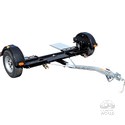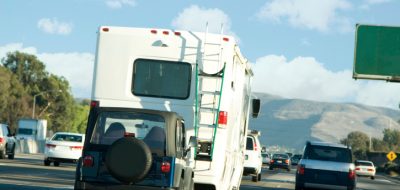 Many motor home owners tow their dinghy four wheels down or employ a dolly, two wheels down. The four down requires a mounting plate adaptor to be installed on the front of the vehicle. This adaptor plate connects in two places to a tow bar that is attached to the motor home’s trailer hitch. The towed vehicle’s steering must be free of any locks so it can move freely. Due to the caster and camber designed into vehicle front ends, the towed vehicle will naturally follow the direction of the tow. Connecting up and disconnecting is quite quick with this method and can be accomplished in minutes.
Many motor home owners tow their dinghy four wheels down or employ a dolly, two wheels down. The four down requires a mounting plate adaptor to be installed on the front of the vehicle. This adaptor plate connects in two places to a tow bar that is attached to the motor home’s trailer hitch. The towed vehicle’s steering must be free of any locks so it can move freely. Due to the caster and camber designed into vehicle front ends, the towed vehicle will naturally follow the direction of the tow. Connecting up and disconnecting is quite quick with this method and can be accomplished in minutes.
Towing with only two wheels on the road uses a short two wheel trailer called a dolly. The front wheels (in some few cases the rear) are driven onto the trailer and secured in place. The dolly, like any trailer, follows the tow vehicle. It essentially is a four wheeled trailer with a longer than normal wheelbase. Connecting up and disconnecting generally involves more work that a tow bar type tow. It takes about 10 minutes to complete.
So, which method is better? Well, they each have advantages and drawbacks and much depends on your preferences.
There are a limited quantity of vehicle makes and models that are capable of towing on all four wheels. Generally this is due to the type of transmissions or presence of all wheel drive. In some cases there are non-approved makes that can be converted for this type of towing by the installing of a drive shaft disconnect device or a stand-alone transmission lubrication pump. This, of course, has a substantial cost and may void the auto’s warranty should a mechanical failure result.
There are two other issues that four down applications have to deal with. The set up does not permit backing up the RV/tow combination, save a straight 15 feet or so. Severe damage to the tow bar and/or adapting plate may occur. Backing up cannot even be accomplished with a person steering the tow. The other common problem is only experienced by high yearly tow mileage, not one trip to the south and back. We are talking about towing four down 10,000 miles or so a year. The tow vehicle’s tires suffer an abnormal wear pattern, generally referred to as “feathering”. This is a result of “wheel barrowing” the tires; towing the auto without its tires experiencing any acceleration, braking, cornering torque, etc. Tires are not designed for that application. The more high performance type the tire, the worse this seems to happen. It produces a slight, but annoying vibration when driving the vehicle.
With the tow dolly, backing is no problem as it handles just like any trailer. Tire feathering seems no issue as this is more prevalent with the front tires. The only two drawbacks to this method are storage needs for the dolly and the additional time required to load and unload.
Be aware, both methods require a braking system, but that’s a topic for a later discussion.
The choice is yours. Both can do the job!







Peter Mercer
Yes I did. I experienced it on two vehicles, an Cadillac Escalade and an S Honda 2000. It seemed the more performance like tire, the more it was affected. The difference probably being, high performance tires having a greater softer compound in the tread. Now, keep in mind, I towed thousands of miles. Not just a trip from Canada to Florida each year. The S 2000 needed a tire replacement even though it only had 3,000 miles on it. I can’t say it affects all vehicles such as non-higher performance like a Jeep, Tracker, or or like tow. I have a Jeep Wrangler that I tow now, currently no issue.
I hope that answers your question.
Anonymous
just reading this, but am going to ask, did you experience this ‘tire feathering’ that is mentioned?
Karla
Sorry, just found this and I have used this site to get a list of 4 down towable vehicles. http://www.edmunds.com/car-buying/what-cars-can-be-flat-towed-behind-an-rv.html
Dan Yancey
Is there a list of cars that can be towed behind a motor home
Bob Finley
I was disappointed that the article didn’t address towing with the vehicle on a trailer. I have a 2008 CRV that we haul on a trailer. The only shortcoming that I found with it is that I have to disconnect the electrical harness to back up because the trailer brakes since the back up motion and apply the trailer brakes. Otherwise, I purchased a trailer tongue weight scale and worked with the car on trailer to determine the correct location for the vehicle. I lag bolted a 4 X 4 across the front trailer where the front wheels are against it and use 3 tiedown straps to cinch it down. So far no problems and getting it off and back on is less than 10 minutes on either end. The trailer weighs 1700 lbs and the allowed tow weight is 5000 lbs with max tongue weight of 500 lbs. I have the actual tongue weight set at 475 lbs. The trailer is a bit of a problem for parking it for an extended period but for overnight only, I just leave it connected. Usually the RV lots have a special space for trailer storage for a couple month stay. The nice thing is that I can back it with the vehicle loaded and only have to unhook the harness. The trailer is a 16 ft dove tail tandem wheel car hauler that cost $2000 new. The trailer is available for other uses when we are home between trips.
brad schiller
the statement about backing up with a tow dolly is wrong.
As . bradbacking up with a tow dolly is a problem as the rear wheels of the vehicle towed goes the other direction of the tow dolly wheels after a short distance
Gary
This is a shallow article that is not terribly accurate. I have had both. The tow dolly adds 400-600 lbs to the weight, are difficult to store and maneuver. Tow dolly are subject to their own problems. Mine was new and had to be re-wired and the tires were not straight forward and the metal tow dolly had to be cut to re-align. Tow dollies are difficult/time consuming to attach to your car. You have to stop at least twice, early on to adjust the tension of the straps. I figured setup of about 45 minutes compared with 10 minutes towing 4 flat. Once your car is on the dolly, you can not back up. The dolly also adds several feet to the length of the tow. Towing 4 flat is perhaps a bit more expensive, but the added costs is well worth verses the hassle of the tow dolly. We bought a Honda CRV that could be towed 4 flats. Many people make sure that they buy a car that can be towed 4 flat.